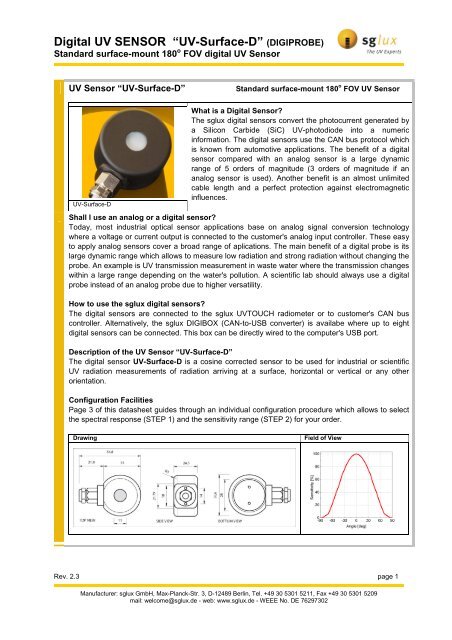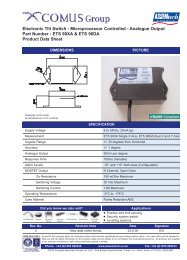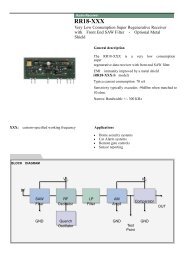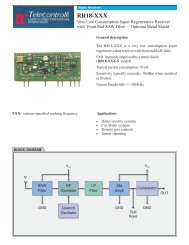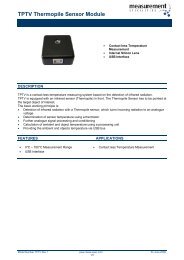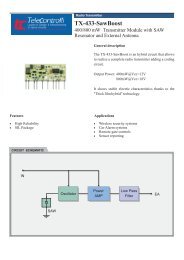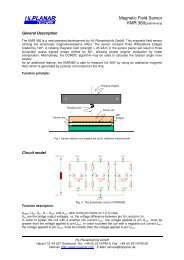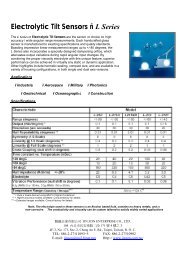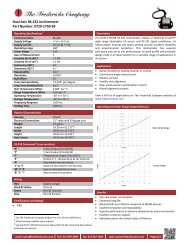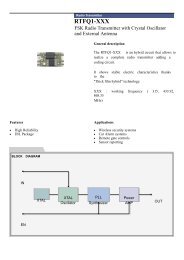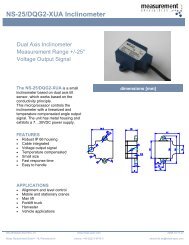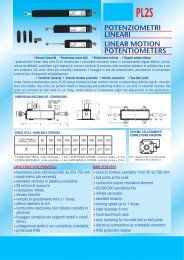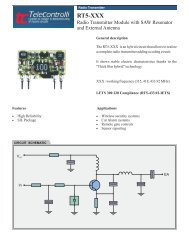Digital UV SENSOR âUV-Surface-Dâ (DIGIPROBE) - sglux
Digital UV SENSOR âUV-Surface-Dâ (DIGIPROBE) - sglux
Digital UV SENSOR âUV-Surface-Dâ (DIGIPROBE) - sglux
Create successful ePaper yourself
Turn your PDF publications into a flip-book with our unique Google optimized e-Paper software.
<strong>Digital</strong> <strong>UV</strong> <strong>SENSOR</strong> “<strong>UV</strong>-<strong>Surface</strong>-D” (<strong>DIGIPROBE</strong>)<br />
Standard surface-mount 180 o FOV digital <strong>UV</strong> Sensor<br />
<strong>UV</strong> Sensor “<strong>UV</strong>-<strong>Surface</strong>-D”<br />
Standard surface-mount 180 o FOV <strong>UV</strong> Sensor<br />
<strong>UV</strong>-<strong>Surface</strong>-D<br />
What is a <strong>Digital</strong> Sensor?<br />
The <strong>sglux</strong> digital sensors convert the photocurrent generated by<br />
a Silicon Carbide (SiC) <strong>UV</strong>-photodiode into a numeric<br />
information. The digital sensors use the CAN bus protocol which<br />
is known from automotive applications. The benefit of a digital<br />
sensor compared with an analog sensor is a large dynamic<br />
range of 5 orders of magnitude (3 orders of magnitude if an<br />
analog sensor is used). Another benefit is an almost unlimited<br />
cable length and a perfect protection against electromagnetic<br />
influences.<br />
Shall I use an analog or a digital sensor?<br />
Today, most industrial optical sensor applications base on analog signal conversion technology<br />
where a voltage or current output is connected to the customer's analog input controller. These easy<br />
to apply analog sensors cover a broad range of aplications. The main benefit of a digital probe is its<br />
large dynamic range which allows to measure low radiation and strong radiation without changing the<br />
probe. An example is <strong>UV</strong> transmission measurement in waste water where the transmission changes<br />
within a large range depending on the water's pollution. A scientific lab should always use a digital<br />
probe instead of an analog probe due to higher versatility.<br />
How to use the <strong>sglux</strong> digital sensors?<br />
The digital sensors are connected to the <strong>sglux</strong> <strong>UV</strong>TOUCH radiometer or to customer's CAN bus<br />
controller. Alternatively, the <strong>sglux</strong> DIGIBOX (CAN-to-USB converter) is availabe where up to eight<br />
digital sensors can be connected. This box can be directly wired to the computer's USB port.<br />
Description of the <strong>UV</strong> Sensor “<strong>UV</strong>-<strong>Surface</strong>-D”<br />
The digital sensor <strong>UV</strong>-<strong>Surface</strong>-D is a cosine corrected sensor to be used for industrial or scientific<br />
<strong>UV</strong> radiation measurements of radiation arriving at a surface, horizontal or vertical or any other<br />
orientation.<br />
Configuration Facilities<br />
Page 3 of this datasheet guides through an individual configuration procedure which allows to select<br />
the spectral response (STEP 1) and the sensitivity range (STEP 2) for your order.<br />
Drawing<br />
Field of View<br />
Rev. 2.3 page 1<br />
Manufacturer: <strong>sglux</strong> GmbH, Max-Planck-Str. 3, D-12489 Berlin, Tel. +49 30 5301 5211, Fax +49 30 5301 5209<br />
mail: welcome@<strong>sglux</strong>.de - web: www.<strong>sglux</strong>.de - WEEE No. DE 76297302
<strong>Digital</strong> <strong>UV</strong> <strong>SENSOR</strong> “<strong>UV</strong>-<strong>Surface</strong>-D” (<strong>DIGIPROBE</strong>)<br />
Standard surface-mount 180 o FOV digital <strong>UV</strong> Sensor<br />
Specifications<br />
Fixed Specifications<br />
Configurable Specifications<br />
Parameter Value Parameter Value<br />
Dimensions<br />
Signal Output<br />
please refer to the drawing<br />
CAN bus signal, 125kbit/s<br />
Pins 1, 7=CAN low, Pins 3, 8= CAN high<br />
Pins 2, 4, 5=GND<br />
Absolute Sensitivity 100nW/cm 2 … 1mW/cm 2<br />
or<br />
5µW/cm 2 … 50mW/cm 2<br />
or<br />
1mW/cm 2 … 10W/cm 2<br />
VSCP protocol according to the following specifications:<br />
http://sourceforge.net/projects/m2m/files/VSCP%20Specification/<br />
Connection 2m cable with 8-Pin male connector<br />
(to converter or else)<br />
Spectral Sensitivity<br />
<strong>UV</strong>-Broadband, <strong>UV</strong>A, <strong>UV</strong>B,<br />
<strong>UV</strong>C, <strong>UV</strong>-Index, <strong>UV</strong>+Blue,<br />
Blue<br />
Temp. Coefficient<br />
Operating Temp.<br />
Humidity<br />
<strong>Digital</strong> <strong>UV</strong> <strong>SENSOR</strong> “<strong>UV</strong>-<strong>Surface</strong>-D” (<strong>DIGIPROBE</strong>)<br />
Standard surface-mount 180 o FOV digital <strong>UV</strong> Sensor<br />
Configuration Guide<br />
STEP 1 Configuration of the Spectral Sensitivity<br />
Please select one spectral sensitivity curve.<br />
STEP 2 Sensitivity<br />
We configure the digital <strong>UV</strong> sensor for intensities across 10 orders of magnitude from 100nW/cm 2 to 10W/cm 2 . Please select<br />
from our standard ranges listed below. Other ranges are available on request.<br />
<strong>sglux</strong> standard ranges<br />
100nW/cm 2 … 1mW/cm 2 5µW/cm 2 … 50mW/cm 2 1mW/cm 2 … 10W/cm 2<br />
Probe mechanical design overview<br />
Besides the ticked mechanical design of this datasheet other mechanical designs are available.<br />
Type<br />
<strong>UV</strong>-<strong>Surface</strong>-D<br />
<strong>UV</strong>-Air-D<br />
<strong>UV</strong>-Cosine-D<br />
<strong>UV</strong>-Water-D<br />
<strong>UV</strong>-DVGW-D<br />
Description<br />
<strong>Digital</strong> Standard surface-mount 180 o FOV <strong>UV</strong> Sensor (this datasheet)<br />
<strong>Digital</strong> Axis oriented in-chamber <strong>UV</strong> Sensor<br />
<strong>Digital</strong> Waterproof <strong>UV</strong> Sensor for outdoor use<br />
<strong>Digital</strong> 10 bar water pressure proof <strong>UV</strong> Sensor<br />
<strong>Digital</strong> <strong>UV</strong> Sensor for DVGW certified water purifiers<br />
Rev. 2.3 page 3<br />
Manufacturer: <strong>sglux</strong> GmbH, Max-Planck-Str. 3, D-12489 Berlin, Tel. +49 30 5301 5211, Fax +49 30 5301 5209<br />
mail: welcome@<strong>sglux</strong>.de - web: www.<strong>sglux</strong>.de - WEEE No. DE 76297302


